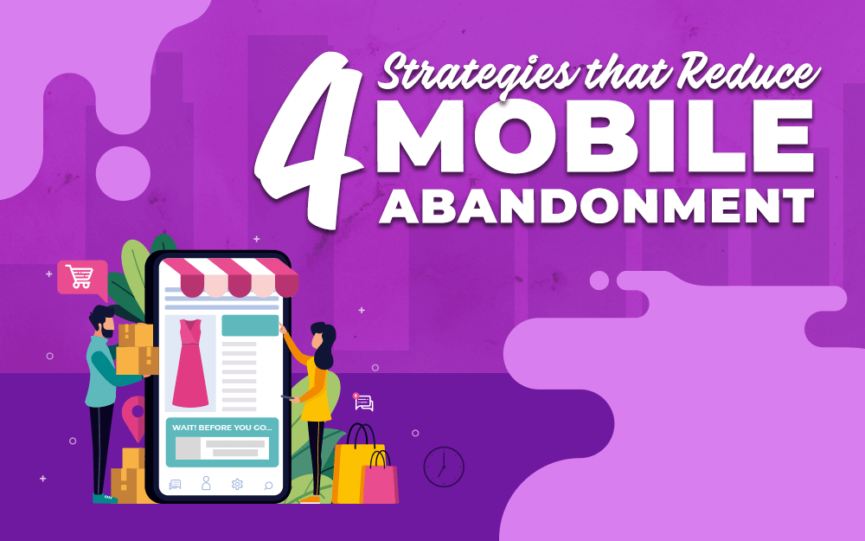The rapid rise of mobile shopping has been nothing short of astounding. Just a decade ago, shopping on a mobile device was relatively new and accounted for very few conversions.
Mobile shopping accounts for two-thirds of ecommerce sessions. Giving consumers the ability to shop anytime, anywhere is great for retailers, but it comes with a caveat: mobile abandonment is extremely high. In fact, over 85% of mobile shopping carts wind up abandoned.
While this is unfortunate, it isn’t exactly surprising. Small screen sizes, traditionally clunky-user experiences, and lack of shopper intent all contribute to this problem.
Though this high abandonment rate can seem daunting, there are a number of ways for ecommerce businesses to drive conversions and reduce mobile abandonment. Let’s take a look.
1. Simplify Your Navigation
One of the largest challenges of mobile shopping comes from the limitations of devices. A typical smartphone screen is between 4 and 5.5 inches – far less than that of the average laptop. Tablets offer a larger screen size, but generally don’t utilize a mouse- which can create browsing difficulties as well.
Mobile sites have to compensate for these disparities by keeping navigation simple and streamlined. While large photos can look great on a desktop homepage, they can be cumbersome to load. If possible, avoid them on mobile.
Make the search bar obvious and easy to find. For your menus, consider condensing some of the options to avoid overwhelming the user. Put your most important buttons and links within easy reach. If a customer is viewing a product page, the “add to cart” button should be immediately visible without the need to scroll.
2. Engage Users With Incentives
Mobile devices have changed the situations in which customers shop. Traditionally, we tend to think of an ecommerce shopper as a person at home, sitting at their computer. While this is often the case for desktop shoppers, mobile devices allow people to shop anywhere. They could be waiting in line, on the bus, or even at their child’s soccer game.
The ability to shop anytime is, in some ways, a double-edged sword. It means more people can shop your site – but it also means customers may use your site as a boredom killer. Basically, they’re window shopping. The end result? A reduction in shopper intent. Whereas customers are often assumed to be interested in products, many users are simply looking for a distraction. This can be great for your daily site visits – but bad for your conversion rates.
Small, limited time incentives are an excellent way to engage low intent visitors. These offers can convince the user to take their shopping more seriously and create true consideration of your products. Even a discount of 10% can be enough to spur users to action and reduce mobile abandonment.
3. Offer to Save Their Cart
Many customers are more comfortable completing their order on a desktop rather than a mobile device. This could be due to security concerns, personal preference, or the perceived difficulty of mobile ordering.
Even if you can’t convert a mobile customer in a single session, you can still use lead capture to recover the conversion later. One of the most simple, effective, and cost-friendly ways to collect their information is by offering to save their cart.
Saving a user’s progress is a way of tailoring your user experience to consumer tastes. It makes it easy for users to pick up where they left off, rather than having to start from scratch. It also gives you their contact information, which allows you to enroll them in future remarketing campaigns.
4. Optimize Your Checkout Process
Mobile checkout has a less than stellar reputation. Mobile screens are small, and retailers need certain customer information in order to carry out their orders. However, it’s important to collect this information as efficiently as possible to mitigate mobile abandonment.
In general, it’s best to ask the bare minimum of mobile shoppers. While you obviously need their address, do you really need their phone number to complete an order?
You can also optimize the payment process by expanding the mobile payments you accept. While credit cards are the norm, the information can be cumbersome to enter, especially since the user could be shopping from anywhere and may not want to take out their credit card.
Consider accepting payments like Google Pay and Apple Pay. These methods shorten the checkout process by allowing users to save payment information on their phone for easy access.
If possible, avoid forcing users to load multiple pages during checkout. Accordion checkouts are great for mobile devices because they expand as users enter their information, without requiring them to load additional pages.
Finally, ensure you’ve enabled guest checkout. While it would be fantastic for every customer to be a registered user, the sign-up process slows down checkout significantly – especially if they’re required to verify their email address. In short: make your checkout as short and easy to navigate as possible.
Making the Most of Mobile
Mobile shopping’s popularity has been growing quickly, and shows no signs of slowing down. By catering to the unique needs of mobile shoppers, you can reduce mobile abandonment, increase engagement, and create more conversions.
Looking for More Ways to Increase Your Conversions?
Check out UpSellit’s 27 Attributes of an Effective Email. This in-depth guide covers the ins-and-outs of crafting the perfect remarketing email. It’s a great resource and it’s totally free! Download it today and start writing awesome emails that convert.

